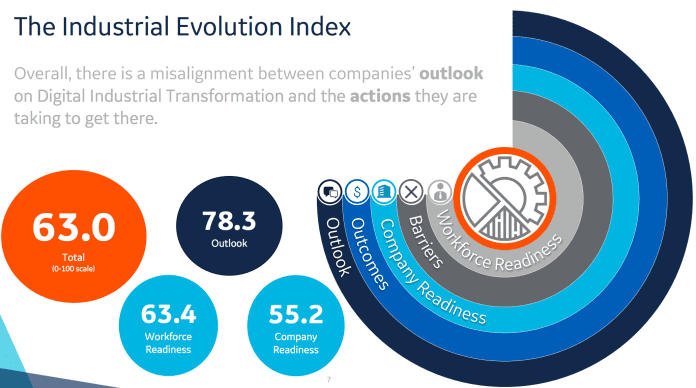Industrial IoT solutions will drive digital transformation, but there’s a gap between outlook and preparations
“The industrial internet is already having a profound impact on industrial companies of all sizes. We know this because we are seeing real benefits with our customers and across GE. At the same time, a gap is emerging between outlook for the [industrial IoT] and actions. We are working to close that gap by partnering with customers to accelerate change and guide companies of all sizes along their digital journeys.”
That was the message delivered this week at the Minds + Machines event in San Francisco by Bill Ruh, CEO, GE Digital. He was citing the industrial powerhouse’s Digital Industrial Evolution Index research, which surveyed information technology and operations decision makers.
Key findings of the research include:
- 80% of respondents think the industrial IoT “could be transformational” and key to competitiveness;
- But only 8% “say digital transformation is ingrained in their businesses;”
- “And 10% do not have a digital transformation plan in place.”
Let’s take a quick look at how GE has enabled digital transformation in three companies in the energy, aviation and railroad industries.
Exelon works in power generation, energy sales, transmission and delivery with a footprint in 48 states, the District of Columbia and Canada. Exelon used GE’s Predix software to bring machine-learning to six of its utilities covering 10 million customers. The predictive analytics Predix brings to the table allow for improved reliability, availability and efficiency of Exelon’s operations, which span nuclear, hydroelectric, natural gas, wind and solar energy facilities.
Australian airline Qantas worked with GE to develop FlightPulse, a bespoke data app that lets pilots optimize routes and reduce fuel consumption and reduce carbon emissions. This application is also pinned to the Predix suite; it captures aircraft data and applies analytics to provide granular insight in operational efficiencies. The implementation allowed Qantas to reduce fuel consumption by around 30 million kilograms. According to GE, “Qantas is now close to doubling its fuel savings compared to this time last year.”
Also in the Australian transportation industry, Australian Rail Track Corporation used GE’s Movement Planner to develop its ARTC Network Control Optimization program to gather real-time rail traffic planning data to optimize its freight movement with the long-term goal of laying the groundwork for a full-blown digital transformation of asset control.

